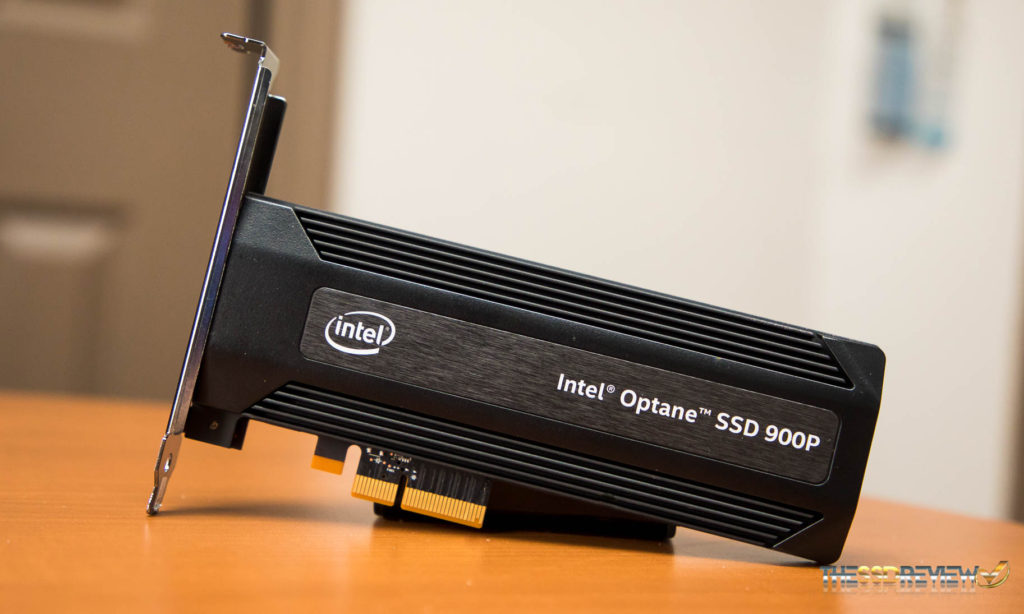SPECIFICATIONS
The Intel Optane SSD 900P is a NVMe solid state drive that has a PCIe 3.0 x4 (four lane) interface. Today, it is available in a HHHL (half height half length) AIC (add in card) in capacities of 280 and 480GB. Sooner than later, we will also see it available in a 2.5″ U.2 interface with a SFF-8639 connector. Latency for the Optane is <10uS while power consumption is 8W read, 13W write, 14W burst and 5W idle.
Manufacturer ‘suggested’ retail pricing is listed at $389 (280GB) and $599 (480GB), however, lack of availability is sure to drive prices up and we found pricing to be double that at Amazon as of the date of this report. Performance is listed at 2.5GB/s read and 2GB/s write with 550K read IOPS and 500K write IOPS, regardless of capacity.
Just as important is the Optane SSD 900P endurance which is listed at 10DWPD (drive writes per day), 0r 8760 TBW (terabytes written) for the 480GB capacity we are testing. To draw a comparable which is similar for all other SSDs, the Samsung 960 Pro 512GB M.2 SSD has an endurance rating of 400TBW, leaving the lifespan of the SSD 900P at just over 21 times longer than that of the Samsung 960 Pro M.2 NVMe SSD. The question then of course becomes one of just how long you will have the drive. Personally speaking, I have never met anyone who has reached end life of an SSD before their decision to upgrade to bigger and better, and in most cases, people will upgrade to bigger and better within a year or two.
INTEL OPTANE SSD 900p TEARDOWN
The Intel SSD 900P can be disassembled through removal of five torque screws, which allow for separation of the backplate, heatsink cover, heatsink, PCB and bracket. Although it is not shown in this picture, there was thermal paste securing all memory and ic packages to the base of the heatsink which allowed for heat dissipation.
On the face of the PCB, we have the Intel SLL3D 7-channel NVMe controller that is also used in the Intel Data Center P4800X SSD, along with 14 chips of Intel 3D XPoint memory. Of particular interest is the fact that there is no DRAM cache seen on this drive, and also, that the TRIM function is disabled for Optane SSDs because of the way they store data differently than other SSDs. As well, an Intel 900P NVMe driver can be downloaded from Intel to better your Optane performance.
Moving to the bottom of the PCB, we find another 14 packages of 3D XPoint memory, all 28 packages providing 447GB of available storage. Seeing 28 packages of 3D XPoint memory clearly answers any concerns as to why Intel hadn’t planned for a M.2 release alongside the AIC and U.2. Each package accounts for 16GB of available storage, although the Optane M.2 is available in 32GB and 64GB capacities for their Optane cache as reviewed here.
 The SSD Review The Worlds Dedicated SSD Education and Review Resource |
The SSD Review The Worlds Dedicated SSD Education and Review Resource | 


How is the heatsink cover attached to the card? Is it possible to remove it without removing the heatsink from the pcb?
Yes it is simply clicked into place. It is very secure though.
awesome! many thanks for this analysis! Especially “REAL WORLD FILE TRANSFER COMPARISON” is great. Have seen this in no other place of optane reviews before. Only thing missing are some words reading boot speed in comparison to other fast but standard ssds (e.g. 960pro)
maybe you can also share some words on how does an optane drive feel in real life (workstation usage)?
Are things faster? E.g. windows file search? looking for windows updates? Sorting folders with 1000 files by date/size/name? Generating previews of images in folders which has not been opened (=cached) before? Virus check?
Thank you for the comps. I haven’t had it as a boot drive just yet so cannot comment on startup or general system activity. Look forward to getting to this in the future though…maybe as a follow up.
“by marketing a new flash”
No. It’s a new class of memory, not flash; those who have analysed it say it’s phase change memory (though Intel denies that).
https://www.techinsights.com/about-techinsights/overview/blog/intel-3D-xpoint-memory-die-removed-from-intel-optane-pcm/
Fair enough… In all honesty though, there still isn’t enough information available to exclude it from the flash category. Intel and Micron are very tight lipped.
Sure there is; it’s been verified as PCM/chalcogenide based:
https://www.techinsights.com/about-techinsights/overview/blog/intel-3D-xpoint-memory-die-removed-from-intel-optane-pcm/
https://www.pcper.com/reviews/Editorial/How-3D-XPoint-Phase-Change-Memory-Works
The theory is the secrecy is due to patents involving Energy Conversion Devices (ECD) which has been going through bankruptcy proceedings for years.
any news on micron’s Quantx ?
The Amazon link failed:
Your search “intel optane ssd 900p” did not match any products.
I’m in Oz.
Something I haven’t seen on these yet, I know the original Optane Cache was only supported by a few Intel chipsets. Is the 900p compatible with AMD platforms? Not seeing any compatibility documentation anywhere…
It’s a regular NVME drive like any other as far as your system is concerned.